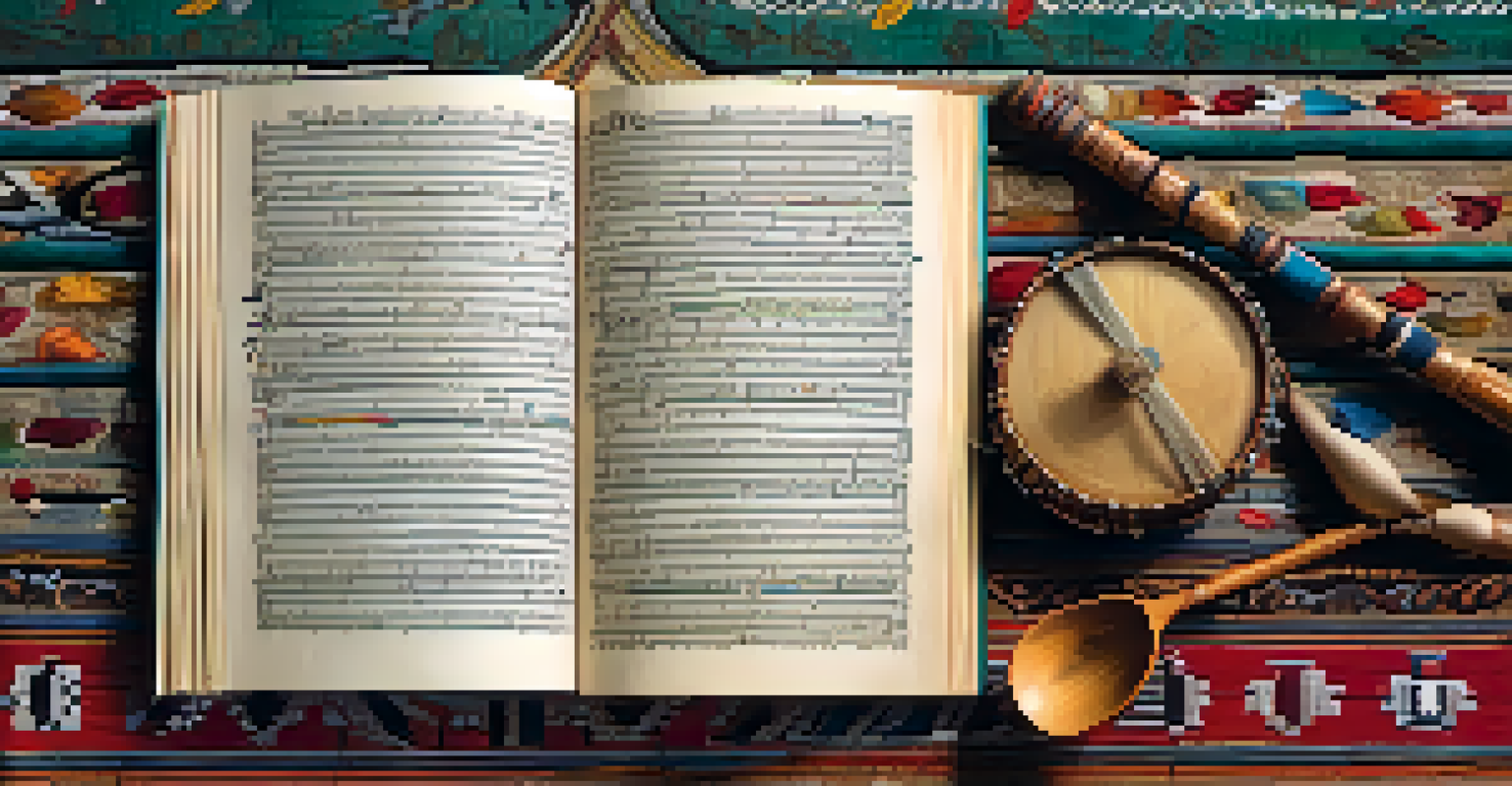Cultural Variations in Music and Their Impact on Language Use

Understanding the Connection Between Music and Language
Music and language share a deep-rooted connection that transcends cultures. Both are forms of communication that convey emotions, stories, and cultural identity. Just as languages have their unique sounds and structures, so too do musical traditions, making them integral to the cultures they represent.
Music is the shorthand of emotion.
For example, consider how a lullaby in one culture might differ dramatically from another. While one might use soft, flowing melodies to evoke calmness, another could utilize rhythmic patterns to promote a sense of security. This illustrates how music reflects the values and emotional landscapes of different societies.
Ultimately, the interplay between music and language suggests that understanding one can enhance our appreciation of the other. As we explore various musical traditions, we also gain insights into the languages and cultures that shape them.
Cultural Identity Expressed Through Music
Music often serves as a powerful expression of cultural identity. From folk songs that tell the history of a community to contemporary genres that address social issues, music encapsulates the essence of a culture. This identity isn’t just about the sound; it’s also about the lyrics and the language used.

Take rap music, for example. Artists often incorporate regional dialects and slang into their lyrics, which not only connects them to their roots but also communicates their experiences and perspectives. The use of specific linguistic styles can foster a sense of belonging among listeners who share similar backgrounds.
Music Enhances Language Learning
Exposure to music can improve children's language acquisition by aiding phonetic awareness and making learning enjoyable.
Thus, music becomes a vessel for cultural storytelling, weaving together language and identity in a way that resonates deeply with its audience. This connection reinforces the idea that understanding music can provide valuable insights into the cultures from which it originates.
Language Acquisition and Musical Influence
Research suggests that exposure to music can enhance language acquisition, especially in children. The rhythmic and melodic elements of music can help with phonetic awareness, making it easier for young learners to grasp the sounds of their native language. This is why many educators incorporate songs into language lessons.
Where words fail, music speaks.
For instance, nursery rhymes often use repetitive phrases and catchy melodies that help children remember new words and phrases. This musical engagement not only aids memory but also makes learning more enjoyable. As a result, children are more likely to develop a love for both music and language.
In this sense, music serves as a bridge, connecting learners with the sounds and structures of their language. This harmonious relationship highlights the potential of music to facilitate language development in diverse settings.
Regional Variations in Musical Language
Different regions boast their own musical styles, which often influence the languages spoken there. For instance, in areas where traditional music thrives, you might find unique dialects or vocabulary that reflect the themes and narratives of the songs. These regional variations can enrich the linguistic tapestry of a culture.
In Scotland, for example, the Gaelic language is closely tied to traditional music. Many songs contain words and phrases that are not commonly used in everyday conversation but hold significant cultural meaning. This creates a distinct linguistic identity that can be traced back to its musical roots.
Cultural Identity Through Music
Music serves as a powerful expression of cultural identity, weaving together language and storytelling that resonates with communities.
Such regional variations remind us that language is not static; it evolves alongside cultural practices, including music. As we listen to the melodies of different regions, we also uncover the layers of language that shape their unique identities.
The Role of Music in Language Preservation
Music plays a crucial role in preserving endangered languages. In many cultures, traditional songs are among the few remaining links to languages that are at risk of fading away. By keeping these musical traditions alive, communities can help ensure their languages remain relevant for future generations.
For instance, Indigenous communities often use songs to pass down stories, history, and language. These songs become a vital means of cultural transmission, allowing younger generations to connect with their heritage while learning the language. This oral tradition is essential for sustaining their linguistic identity.
Thus, music not only serves as a means of expression but also acts as a powerful tool for language preservation. By valuing and promoting musical traditions, we can help safeguard the languages that are integral to cultural diversity.
Music as a Universal Language
One fascinating aspect of music is its ability to transcend linguistic barriers. Regardless of the language spoken, music can evoke emotions and connect people on a fundamental level. This universality allows for a shared experience that often fosters understanding and empathy across cultures.
For instance, think about how a powerful melody can bring people to tears, even if they don’t understand the lyrics. The emotional weight carried by the music often speaks louder than words, creating a connection that goes beyond language. This phenomenon highlights the intrinsic power of music as a form of communication.
Music Preserves Endangered Languages
Traditional songs play a crucial role in preserving endangered languages, allowing communities to pass down their heritage through music.
As such, music serves as a reminder that while languages may vary, the emotional experiences they convey can unify us. In a world that can often feel divided, music offers a pathway to connection and understanding.
Conclusion: The Interplay of Music and Language
In conclusion, the relationship between music and language is complex yet profoundly impactful. Through music, we can explore cultural identities, enhance language acquisition, and even preserve endangered languages. Each note and lyric carries the weight of cultural significance, making music an essential aspect of human communication.
As we navigate through different musical traditions, we not only enjoy the melodies but also gain insights into the languages and cultures they represent. This interplay enriches our understanding of humanity and fosters a deeper appreciation for the diversity of expression.

Ultimately, recognizing the connection between music and language encourages us to celebrate cultural diversity and promote understanding across different backgrounds. Through music, we find common ground and shared experiences that transcend the barriers of language.